
Animation is a method by which still figures are manipulated to appear as moving images. In traditional animation, images are drawn or painted by hand on transparent celluloid sheets to be photographed and exhibited on film. Today, many animations are made with computer-generated imagery (CGI). Computer animation can be very detailed 3D animation, while 2D computer animation can be used for stylistic reasons, low bandwidth, or faster real-time renderings. Other common animation methods apply a stop motion technique to two- and three-dimensional objects like paper cutouts, puppets, or clay figures.
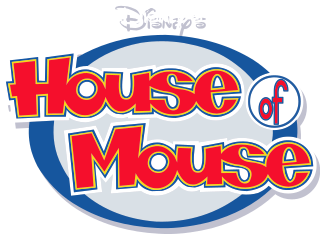
Disney's House of Mouse is an American animated television series produced by Walt Disney Television Animation that originally aired for three seasons on ABC and Toon Disney from January 13, 2001, to its finale on October 24, 2003, with 52 episodes and 22 newly produced cartoon shorts made for the series. The show focuses on Mickey Mouse and his friends running a cartoon theater dinner club in the fictional ToonTown, catering to many characters from Disney cartoons and animated movies while showcasing a variety of their cartoon shorts. The series is named after a common nickname or epithet for the Walt Disney Company.
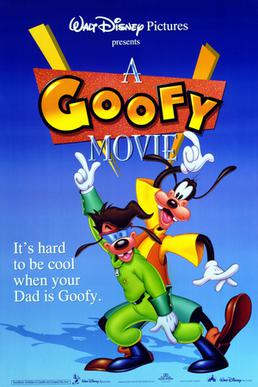
A Goofy Movie is a 1995 American animated musical comedy-adventure film produced by Disney MovieToons and Walt Disney Television Animation. Directed by Kevin Lima, the film is based on The Disney Afternoon television series Goof Troop created by Robert Taylor and Michael Peraza Jr., and serves as a standalone follow-up to the show. It features the voices of Bill Farmer, Jason Marsden, Jim Cummings, Kellie Martin, Rob Paulsen, Pauly Shore, Jenna von Oÿ, and Wallace Shawn. Taking place three years after the events of Goof Troop, the film follows Goofy and his son, Max, who is now in high school, and revolves around the father-son relationship between the two as Goofy embarks on a misguided mission to bond with his son by taking him on a cross-country fishing trip.

Cutout animation is a form of stop-motion animation using flat characters, props and backgrounds cut from materials such as paper, card, stiff fabric or photographs. The props would be cut out and used as puppets for stop motion. The world's earliest known animated feature films were cutout animations, as is the world's earliest surviving animated feature Die Abenteuer des Prinzen Achmed (1926) by Lotte Reiniger.

An American Tail is a 1986 American animated musical adventure film directed by Don Bluth and written by Judy Freudberg and Tony Geiss from a story by David Kirschner, Freudberg and Geiss. The film stars the voices of Phillip Glasser, John Finnegan, Amy Green, Nehemiah Persoff, Dom DeLuise, and Christopher Plummer. It is the story of Fievel Mousekewitz and his family as they emigrate from Russia to the United States for freedom. However, he gets lost and must find a way to reunite with them.
Paddy Kingsland is a composer of electronic music best known for his incidental music for science fiction series on BBC radio and television whilst working at the BBC Radiophonic Workshop. Educated at Eggar's Grammar School in Alton, Hampshire, he joined the BBC as a tape editor before moving on to become a studio manager for BBC Radio 1. In 1970 he joined the Radiophonic Workshop where he remained until 1981. His initial work was mostly signature tunes for BBC radio and TV programmes before going on to record incidental music for programmes including The Changes, two versions of The Hitchhiker's Guide to the Galaxy, as well as several serials of Doctor Who. His work on the latter series included incidental music for several serials in the early 1980s.
Pigeon Street is a cutout animated children's television series, written by Michael Cole, originally shown on the BBC in 1981 as part of its 'See-Saw' strand for preschoolers. There were two series with eight and five episodes respectively, each programme lasting 15 minutes. The series was repeated a number of times until 1994.

Three Little Pigs is an animated short film released on May 25, 1933 by United Artists, produced by Walt Disney and directed by Burt Gillett. Based on the fable of the same name, the Silly Symphony won the 1934 Academy Award for Best Animated Short Film of 1933. The short cost $22,000 and grossed $250,000.
{{Infobox film | name = King-Size Canary | image = Kingsizecanary.jpg | caption = Original title card for the short | director = William Hanna | story = Heck Allen | animator = [[Ed Barge (animator)|Ed
[[Al Grandma in] Barge]]
Robert Bentley
Walt Clinton | starring = Frank Graham
Pinto Colvig
Sara Berner | music = Scott Bradley | producer = Fred Quimby | studio = MGM Cartoons | distributor = Metro-Goldwyn-Mayer

"It's Five O'Clock Somewhere" is a song performed by Alan Jackson and Jimmy Buffett, and written by Jim "Moose" Brown and Don Rollins. It was released in June 2003 as the lead single from Jackson's 2003 compilation album Greatest Hits Volume II. It spent eight non-consecutive weeks at #1 on the Billboard Hot Country Songs chart in the summer of 2003, and ranked #4 on the year-end Billboard Hot Country Songs chart. In addition, the song peaked at #17 on the Billboard Hot 100 chart in September 2003, and ranked #65 on the year-end Billboard Hot 100 chart, making it the biggest pop hit for Jackson and the first top forty hit for Buffett since the 1970s.
The Midnight Snack is a Tom and Jerry cartoon released on July 19, 1941. It is the second of the Tom and Jerry films, returning to the basic premise of the previous film, Puss Gets the Boot, following that cartoon's Academy Awards nomination.
Robie Lester was an American actress, singer, voice artist, and author, best known as the voice of "Miss Jessica" in the Rankin/Bass animated special Santa Claus is Comin' to Town, the singing voice of Eva Gabor in Disney's The Aristocats and The Rescuers, and the original "Disneyland Story Reader" for Walt Disney Records read-alongs.
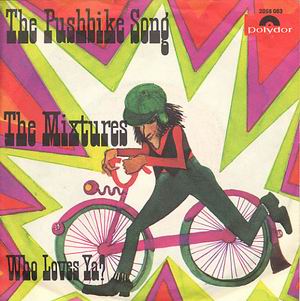
"The Pushbike Song" is a song originally recorded by Australian band The Mixtures and released in 1970. The single was a chart success, reaching numbers one and two in the Australian and UK charts respectively. It has subsequently been covered by various artists.
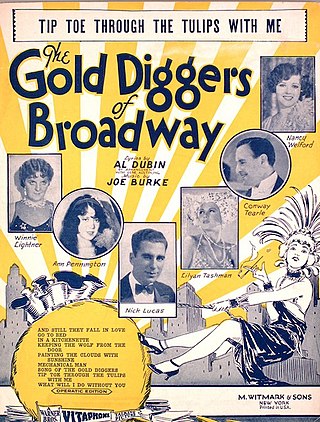
"Tiptoe Through the Tulips", also known as "Tip Toe Through the Tulips with Me", is a popular song published in 1929. The song was written by Al Dubin (lyrics) and Joe Burke (music) and made popular by guitarist Nick Lucas. On February 5, 1968, singer Tiny Tim made the song a novelty hit by singing it on the popular American television show Rowan & Martin's Laugh-In.
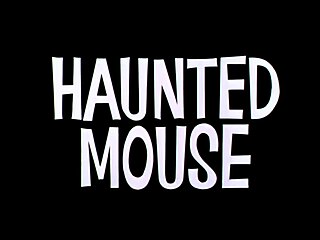
Haunted Mouse is a 1965 Tom and Jerry short directed and produced by Chuck Jones. The title is a play on words of "haunted house".
"Somewhere", sometimes referred to as "Somewhere (There's a Place for Us)" or simply "There's a Place for Us", is a song from the 1957 Broadway musical West Side Story that was made into films in 1961 and 2021. The music is composed by Leonard Bernstein with lyrics by Stephen Sondheim.

The Mouse That Jack Built is a 1959 Warner Bros. Merrie Melodie cartoon short starring Jack Benny and the regular cast of The Jack Benny Program as mice. The short, released on April 4, 1959, was written by Tedd Pierce and directed by Robert McKimson.

The Haunted House, also known as Haunted House, is a 1929 Mickey Mouse short animated film released by Celebrity Productions, as part of the Mickey Mouse film series. The cartoon was produced by Walt Disney Productions and distributed by Celebrity Productions. It was the fourteenth Mickey Mouse short to be produced, the eleventh of that year.
Traffic Troubles is a Mickey Mouse short animated film first released on March 7, 1931, as part of the Mickey Mouse film series. It was the twenty-sixth Mickey Mouse short to be produced, and the second of 1931.
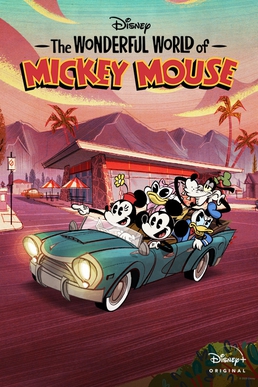
The Wonderful World of Mickey Mouse is an American animated streaming television series produced by Disney Television Animation for Disney+. The series is a continuation and revival of the Emmy Award-winning 2013 Mickey Mouse shorts, uses the same style, and has many of the same cast and crew, with the exception of the late Russi Taylor, who was replaced by Kaitlyn Robrock in the role of Minnie Mouse. The series premiered on November 18, 2020 to coincide with Mickey's 92nd birthday. The animation is provided by Mercury Filmworks.












